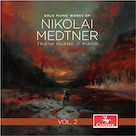

Frank Huang: Solo Piano Works of Nikolai Medtner, Volume 2
Centaur Records
No less a composer than Sergei Rachmaninov deemed Nikolai Medtner (1880-1951) “the greatest composer of his time,” yet despite that he languished in obscurity for much of his life, and today his name is less known than it should be. That's, at least, the conviction indubitably held by the renowned Cincinnati-based pianist and Associate Professor of Piano at Miami University Frank Huang, whose latest Medtner volume is the second in a project that will ultimately encompass nine discs and present all of the Russian's solo piano works. A stronger advocate for a composer would be hard to imagine.
Lightning struck the young pianist when a classmate at The Juilliard School performed Medtner's Sonata tragica (included in the first volume), and the visceral impact the music had on Huang was immediate and transformative. He cites Medtner's “spellbinding harmonic language” as its strongest compositional attribute, but, as the seventy-seven-minute second volume shows, there's considerably more to appreciate. The richness of his contrapuntal writing, his seamless merging of the Germanic and Russian traditions, the music's lyricism, the composer's connection to Russian folklore—all come into play as Steinway artist Huang brings his consummate command and interpretive insight to the five works presented. Recorded at Blue Griffin Studio in Lansing, Michigan and co-produced and engineered by Sergei Kvitko, the set frames three evocative works sharing the Fairy Tales title with the Sonata Triad, Op. 11 and the single-movement Sonata in G Minor, Op. 22.
Collected under the title Sonata Triad, the opening trilogy of one-movement sonatas was dedicated by Medtner to his brother-in-law, who committed suicide in 1906—a detail that perhaps accounts in part for the music's lyrical poignancy. In liner notes, Huang clarifies that a three-part poem by Goethe also serves as an analogue of sorts to the triad, with its titles To Werther, Elegy, and Atonement corresponding to the character of the sonatas. The harmonic elegance and rapid expansion of the ruminative opening part, marked “Allegro non troppo,” captivate quickly, and like much of the material here the thoughtfully structured material develops with clarity, coherence, and intelligence. Tenderness permeates the central part, its “Andante molto espressivo (Sonata-Elegy)” marking making the Goethe connection explicit, and it's in these delicate passages that Huang's artistry comes fully to the fore. Arguably the most melodically beguiling of the three, the “Allegro moderato, con passione innocente” third sonata deftly blends the gracefulness and vitality of the first with the lyrical quality of the second.
The melodic allure of Medtner's music distinguishes the three sets of Fairy Tales pieces, beginning with the four that make up opus twenty-six. The radiantly glowing first sparkles with Ravel-esque splendour in its outdoorsy evocation, the second bursts in its first moment with irrepressible joy and energy, the introspective third exudes dignity and delicacy, and the fourth punctuates dramatic musings with playful devilry. In contrast to the four-part design of the other two sets, Fairy Tales, Op. 20 comprises two movements only, its sombre “Allegro con espressione” marked by drama and its relentless “Pesante. Minaccioso (Campanella)” an exercise in obsession. Fairy Tales, Op. 34 begins with a movement that swells from a solemn intro into a playful dance-enlivened romp before moving onto a breezy folk reverie and a macabre tryst with death. In keeping with a story associated with a Pushkin poem about a blasphemous knight who on his deathbed ascends to heaven after the Blessed Virgin intervenes, the music in the closing movement undergoes transfiguration in transitioning from an anguished D minor melody to a radiant D major. The movement's so effective as a standalone statement, it would be a perfect encore for a Medtner-themed recital.
The release's most elaborate piece is, naturally, the Sonata in G Minor, Op. 22 when its unfolding transpires across seventeen minutes. An ominous five-note theme sets a portentous tone, after which multiple thematic transformations and variations occur in a work that evolves through distinct episodes. Huang's virtuosity is called upon during the most intense and dynamic passages, but his artistry is sustained throughout. All of the album's finessed treatments speak to the depth of his connection to Medtner, as well as the pianist's mature grasp of the composer's world; one would be hard pressed to find performances more authoritative than Huang's. A Gramophone writer opined that “Huang and Medtner are made for one another” and that the pianist “can hold his own next to Marc-André Hamelin”—high praise indeed but based on the evidence fully warranted.April 2025